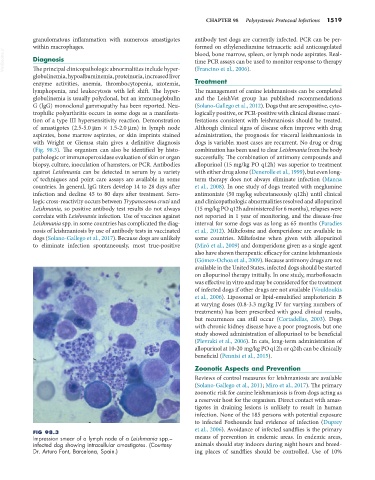Page 1547 - Small Animal Internal Medicine, 6th Edition
P. 1547
CHAPTER 98 Polysystemic Protozoal Infections 1519
granulomatous inflammation with numerous amastigotes antibody test dogs are currently infected. PCR can be per-
within macrophages. formed on ethylenediamine tetraacetic acid anticoagulated
VetBooks.ir Diagnosis blood, bone marrow, spleen, or lymph node aspirates. Real-
time PCR assays can be used to monitor response to therapy
The principal clinicopathologic abnormalities include hyper-
globulinemia, hypoalbuminemia, proteinuria, increased liver (Francino et al., 2006).
enzyme activities, anemia, thrombocytopenia, azotemia, Treatment
lymphopenia, and leukocytosis with left shift. The hyper- The management of canine leishmaniosis can be completed
globulinemia is usually polyclonal, but an immunoglobulin and the LeishVet group has published recommendations
G (IgG) monoclonal gammopathy has been reported. Neu- (Solano-Gallego et al., 2012). Dogs that are seropositive, cyto-
trophilic polyarthritis occurs in some dogs as a manifesta- logically positive, or PCR-positive with clinical disease mani-
tion of a type III hypersensitivity reaction. Demonstration festations consistent with leishmaniosis should be treated.
of amastigotes (2.5-5.0 µm × 1.5-2.0 µm) in lymph node Although clinical signs of disease often improve with drug
aspirates, bone marrow aspirates, or skin imprints stained administration, the prognosis for visceral leishmaniosis in
with Wright or Giemsa stain gives a definitive diagnosis dogs is variable; most cases are recurrent. No drug or drug
(Fig. 98.3). The organism can also be identified by histo- combination has been used to clear Leishmania from the body
pathologic or immunoperoxidase evaluation of skin or organ successfully. The combination of antimony compounds and
biopsy, culture, inoculation of hamsters, or PCR. Antibodies allopurinol (15 mg/kg PO q12h) was superior to treatment
against Leishmania can be detected in serum by a variety with either drug alone (Denerolle et al., 1999), but even long-
of techniques and point care assays are available in some term therapy does not always eliminate infection (Manna
countries. In general, IgG titers develop 14 to 28 days after et al., 2008). In one study of dogs treated with meglumine
infection and decline 45 to 80 days after treatment. Sero- antimoniate (50 mg/kg subcutaneously q12h) until clinical
logic cross-reactivity occurs between Trypanosoma cruzi and and clinicopathologic abnormalities resolved and allopurinol
Leishmania, so positive antibody test results do not always (15 mg/kg PO q12h administered for 6 months), relapses were
correlate with Leishmania infection. Use of vaccines against not reported in 1 year of monitoring, and the disease-free
Leishmania spp. in some countries has complicated the diag- interval for some dogs was as long as 65 months (Paradies
nosis of leishmaniosis by use of antibody tests in vaccinated et al., 2012). Miltefosine and domperidone are available in
dogs (Solano-Gallego et al., 2017). Because dogs are unlikely some countries. Miltefosine when given with allopurinol
to eliminate infection spontaneously, most true-positive (Miró et al., 2009) and domperidone given as a single agent
also have shown therapeutic efficacy for canine leishmaniosis
(Gómez-Ochoa et al., 2009). Because antimony drugs are not
available in the United States, infected dogs should be started
on allopurinol therapy initially. In one study, marbofloxacin
was effective in vitro and may be considered for the treatment
of infected dogs if other drugs are not available (Vouldoukis
et al., 2006). Liposomal or lipid-emulsified amphotericin B
at varying doses (0.8-3.3 mg/kg IV for varying numbers of
treatments) has been prescribed with good clinical results,
but recurrences can still occur (Cortadellas, 2003). Dogs
with chronic kidney disease have a poor prognosis, but one
study showed administration of allopurinol to be beneficial
(Plevraki et al., 2006). In cats, long-term administration of
allopurinol at 10-20 mg/kg PO q12h or q24h can be clinically
beneficial (Pennisi et al., 2015).
Zoonotic Aspects and Prevention
Reviews of control measures for leishmaniosis are available
(Solano-Gallego et al., 2011; Miro et al., 2017). The primary
zoonotic risk for canine leishmaniosis is from dogs acting as
a reservoir host for the organism. Direct contact with amas-
tigotes in draining lesions is unlikely to result in human
infection. None of the 185 persons with potential exposure
to infected Foxhounds had evidence of infection (Duprey
FIG 98.3 et al., 2006). Avoidance of infected sandflies is the primary
Impression smear of a lymph node of a Leishmania spp.– means of prevention in endemic areas. In endemic areas,
infected dog showing intracellular amastigotes. (Courtesy animals should stay indoors during night hours and breed-
Dr. Arturo Font, Barcelona, Spain.) ing places of sandflies should be controlled. Use of 10%

